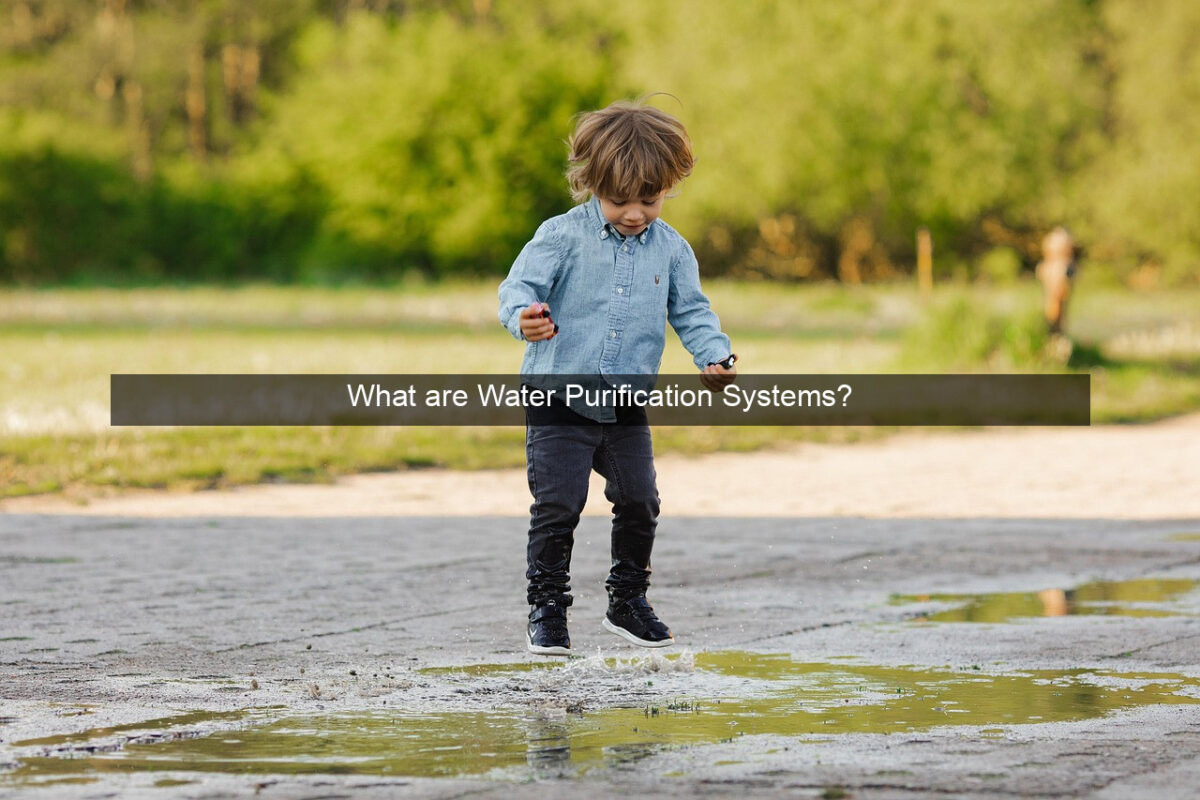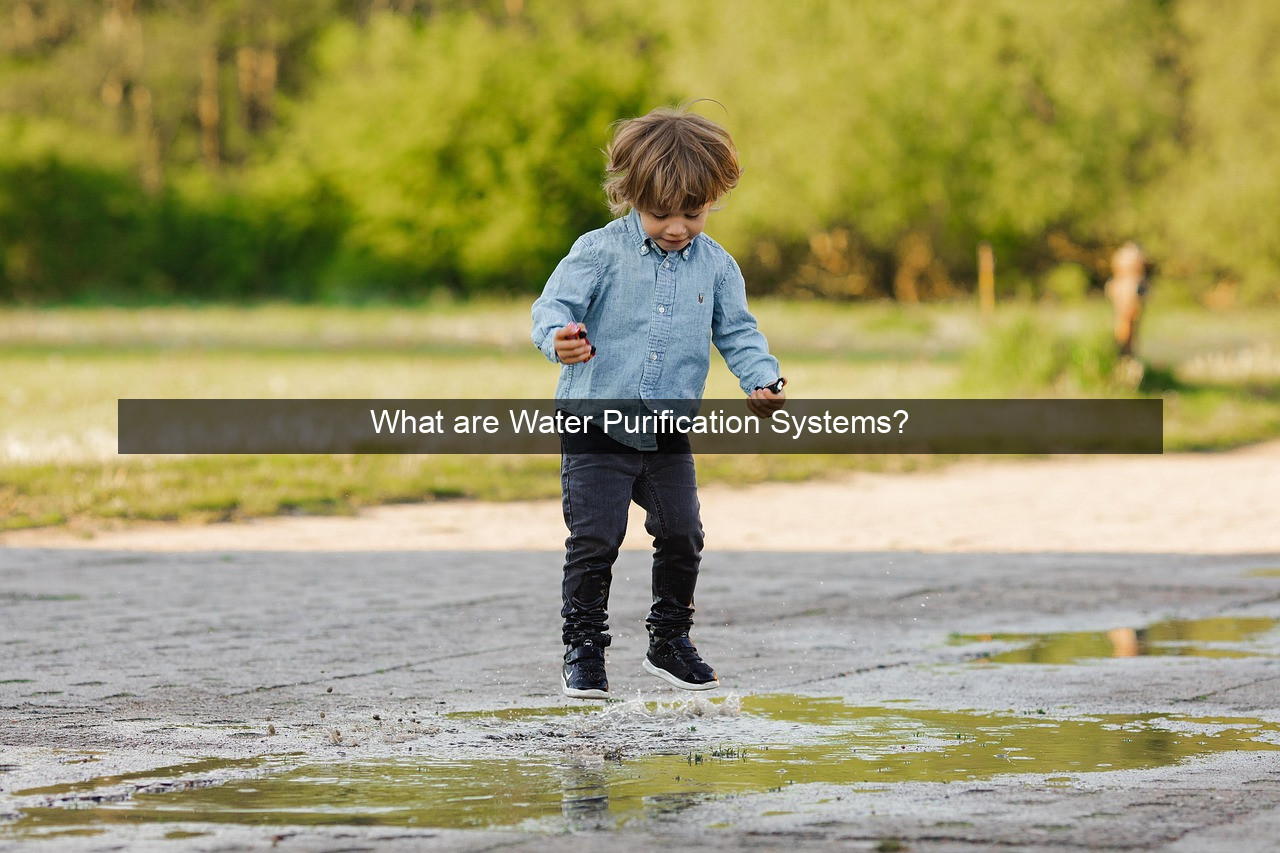What are Water Purification Systems?

- What are Water Purification Systems?
- What are Water Purification Systems?
- Types of Water Purification Systems
- Reverse Osmosis Systems
- Ultraviolet (UV) Water Purifiers
- Water Filter Pitchers
- Benefits of Water Purification Systems
- Healthier Drinking Water
- Improved Taste and Odor
- Cost Savings
- Choosing the Right System
- Factors to Consider
- Maintenance Requirements
- Conclusion

What are Water Purification Systems?

Access to clean, safe drinking water is a fundamental human right, yet millions worldwide lack this basic necessity. Contaminated water poses significant health risks, leading to various waterborne diseases. This underscores the critical importance of water purification systems in ensuring access to potable water. These systems employ various technologies to remove impurities, contaminants, and harmful microorganisms, making water safe for consumption and other domestic uses. From simple filtration methods to advanced treatment processes, water purification systems play a vital role in protecting public health and improving overall well-being. Understanding the different types of systems, their functionalities, and their benefits can empower individuals and communities to make informed decisions about their water safety.
Types of Water Purification Systems
Reverse Osmosis Systems
Reverse osmosis (RO) systems are highly effective in removing a wide range of contaminants from water. They utilize a semipermeable membrane to filter out dissolved solids, minerals, and impurities. This process effectively removes bacteria, viruses, heavy metals, and other harmful substances. RO systems are known for their ability to produce high-quality purified water suitable for drinking and cooking.
The RO process involves applying pressure to force water through the membrane, leaving behind contaminants. The purified water is then collected, while the wastewater containing the rejected impurities is discharged. RO systems are popular choices for households and businesses seeking comprehensive water purification.
These systems offer significant advantages in terms of water quality and safety. They effectively remove a broad spectrum of contaminants, ensuring the delivery of clean and healthy drinking water. While they require regular maintenance, the benefits of RO systems in safeguarding public health are undeniable.
Ultraviolet (UV) Water Purifiers
Ultraviolet (UV) water purifiers utilize UV light to disinfect water by destroying harmful microorganisms like bacteria and viruses. The UV light disrupts the DNA of these microorganisms, rendering them incapable of reproduction and effectively neutralizing them. This process does not remove dissolved solids or minerals, making it ideal for treating water that is already relatively clean but may contain microbial contaminants.
UV purification is a chemical-free method of disinfection, ensuring that no harmful byproducts are introduced into the water. This makes it a safe and environmentally friendly option for water treatment. UV systems are often used in conjunction with other purification methods to provide comprehensive water treatment solutions.
UV purifiers are relatively easy to install and maintain, making them a convenient choice for many households. They are effective in eliminating harmful pathogens, providing an added layer of protection against waterborne diseases. Their chemical-free operation makes them an attractive option for those seeking sustainable water treatment solutions.
Water Filter Pitchers
Water filter pitchers offer a simple and affordable way to improve the taste and quality of drinking water. These pitchers contain a filter cartridge that removes sediment, chlorine, and other impurities. They are convenient for small households or individuals seeking a basic level of water filtration.
Filter pitchers are easy to use and do not require any installation. Simply fill the pitcher with tap water and allow it to filter through the cartridge. The filtered water is then ready for consumption. While not as comprehensive as other purification systems, filter pitchers provide a cost-effective solution for improving water quality.
The filter cartridges in these pitchers need to be replaced regularly to maintain their effectiveness. While they primarily improve taste and odor, some filters also reduce certain contaminants. Filter pitchers are a practical option for those seeking a simple and budget-friendly water filtration solution.
Benefits of Water Purification Systems
Healthier Drinking Water
Water purification systems play a crucial role in providing access to healthier drinking water. By removing harmful contaminants, these systems protect against waterborne diseases and promote overall well-being. Clean drinking water is essential for hydration, nutrient absorption, and various bodily functions.
Consuming contaminated water can lead to a range of health issues, from mild gastrointestinal problems to serious illnesses. Water purification systems effectively eliminate these risks, ensuring the delivery of safe and healthy drinking water for families and communities.
Investing in a quality water purification system is an investment in health and well-being. It provides peace of mind knowing that the water consumed is free from harmful impurities and contributes to a healthier lifestyle.
Improved Taste and Odor
Many water purification systems improve the taste and odor of water by removing chlorine, sediment, and other impurities that can affect its palatability. This enhances the drinking experience and encourages increased water consumption.
Chlorine, while effective in disinfecting water, can leave an unpleasant taste and odor. Water purification systems effectively remove chlorine, resulting in cleaner, fresher-tasting water.
Improved taste and odor can encourage individuals, especially children, to drink more water, promoting better hydration and overall health. This is a significant benefit of using a water purification system.
Cost Savings
While there is an initial investment involved in purchasing a water purification system, it can lead to cost savings in the long run. By eliminating the need for bottled water, households can significantly reduce their expenses.
Bottled water can be a significant expense, especially for families. Water purification systems provide a cost-effective alternative, delivering clean and safe drinking water directly from the tap.
In addition to financial savings, using a water purification system also reduces plastic waste, contributing to environmental sustainability.
Choosing the Right System
Factors to Consider
Choosing the right water purification system depends on various factors, including water quality, budget, household size, and specific needs. It’s essential to assess these factors to determine the most suitable system.
Testing your water quality can help identify the specific contaminants present and guide the selection of an appropriate purification system. Budget considerations play a role in determining the affordability and long-term costs of different systems.
Household size and water usage patterns influence the capacity and efficiency requirements of the chosen system. Considering these factors ensures the selection of a system that meets the specific needs of the household.
Maintenance Requirements
Different water purification systems have varying maintenance requirements. Understanding these requirements is crucial for ensuring the system’s longevity and effectiveness.
Regular filter replacements are essential for most systems to maintain optimal performance. Some systems may require periodic cleaning or sanitization. Understanding and adhering to the manufacturer’s recommended maintenance schedule is crucial.
Proper maintenance ensures the continued delivery of clean and safe water and prolongs the lifespan of the water purification system.
| System Type | Cost | Maintenance |
|---|---|---|
| Reverse Osmosis | Moderate to High | Moderate |
| UV Purifier | Low to Moderate | Low |
| Water Filter Pitcher | Low | Low |
- Consider your water source.
- Think about your budget.
- Research different brands.
Conclusion
Investing in a water purification system is a crucial step towards ensuring access to clean, safe, and healthy drinking water. The various types of systems available cater to different needs and budgets, offering a range of options for individuals and communities. By understanding the benefits and functionalities of these systems, informed decisions can be made to protect health and well-being.
What are the main types of water purification systems?
Common types include reverse osmosis, ultraviolet (UV) purifiers, water filter pitchers, and whole-house systems.
How do I choose the right water purification system?
Consider your water source, budget, household size, and specific contaminant removal needs.
What are the benefits of using a water purification system?
Benefits include healthier drinking water, improved taste and odor, and potential cost savings compared to bottled water.
How often do water filter cartridges need to be replaced?
Replacement frequency varies depending on the system and usage, typically every few months.



